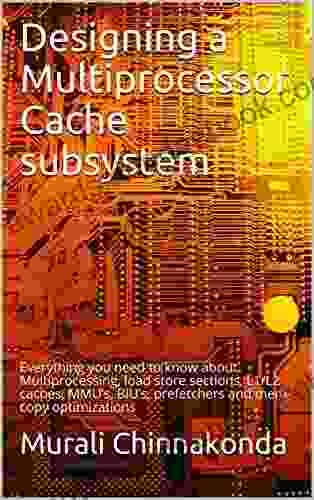Everything You Need to Know About Multiprocessing Load Store Sections L1 L2 L3 Cache Coherency

Multiprocessing is a computing paradigm in which multiple processors share a common memory space. This allows for parallel execution of tasks, which can improve performance. However, multiprocessing also introduces a number of challenges, one of which is cache coherency.
5 out of 5
| Language | : | English |
| File size | : | 6508 KB |
| Screen Reader | : | Supported |
| Print length | : | 43 pages |
Cache coherency is the problem of ensuring that all processors have a consistent view of the data in memory. When multiple processors are accessing the same data, it is possible for one processor to modify the data while another processor is reading it. This can lead to incorrect results.
To address the problem of cache coherency, modern processors implement a number of hardware mechanisms, including load store sections, L1 caches, L2 caches, and L3 caches. These mechanisms work together to ensure that all processors have a consistent view of the data in memory.
Load Store Sections
Load store sections are a hardware mechanism that helps to ensure cache coherency. Load store sections are small regions of memory that are used to store data that is being accessed by multiple processors. When a processor wants to read data from memory, it first checks to see if the data is in a load store section. If the data is in a load store section, the processor can read the data directly from the load store section. This avoids the need to access the main memory, which can be much slower.
When a processor wants to write data to memory, it first writes the data to a load store section. The data is then written to the main memory from the load store section. This helps to ensure that all processors have a consistent view of the data in memory.
L1 Caches
L1 caches are small, high-speed caches that are located on the processor chip. L1 caches store the most frequently accessed data and instructions. When a processor needs to access data or instructions, it first checks to see if the data or instructions are in the L1 cache. If the data or instructions are in the L1 cache, the processor can access the data or instructions directly from the L1 cache. This avoids the need to access the main memory, which can be much slower.
L2 Caches
L2 caches are larger, slower caches that are located off the processor chip. L2 caches store data and instructions that are not frequently accessed. When a processor needs to access data or instructions that are not in the L1 cache, it checks to see if the data or instructions are in the L2 cache. If the data or instructions are in the L2 cache, the processor can access the data or instructions directly from the L2 cache. This avoids the need to access the main memory, which can be much slower.
L3 Caches
L3 caches are large, slow caches that are located off the processor chip. L3 caches store data and instructions that are not frequently accessed. When a processor needs to access data or instructions that are not in the L1 or L2 caches, it checks to see if the data or instructions are in the L3 cache. If the data or instructions are in the L3 cache, the processor can access the data or instructions directly from the L3 cache. This avoids the need to access the main memory, which can be much slower.
Cache Coherency
Cache coherency is the problem of ensuring that all processors have a consistent view of the data in memory. When multiple processors are accessing the same data, it is possible for one processor to modify the data while another processor is reading it. This can lead to incorrect results.
To address the problem of cache coherency, modern processors implement a number of hardware mechanisms, including load store sections, L1 caches, L2 caches, and L3 caches. These mechanisms work together to ensure that all processors have a consistent view of the data in memory.
When a processor writes data to memory, the data is first written to a load store section. The data is then written to the main memory from the load store section. This ensures that all processors see the updated data.
When a processor reads data from memory, it first checks to see if the data is in a load store section. If the data is in a load store section, the processor reads the data from the load store section. This ensures that the processor reads the most up-to-date data.
If the data is not in a load store section, the processor reads the data from the main memory. The processor then writes the data to a load store section. This ensures that other processors see the updated data.
Performance Implications
The use of load store sections, L1 caches, L2 caches, and L3 caches can have a significant impact on performance. By storing frequently accessed data and instructions in caches, processors can avoid the need to access the main memory, which can be much slower. This can lead to significant improvements in performance.
The size and speed of the caches can also have a significant impact on performance. Larger caches can store more data and instructions, which can reduce the number of times that the processor needs to access the main memory. Faster caches can access data and instructions more quickly, which can also improve performance.
Load store sections, L1 caches, L2 caches, and L3 caches are essential hardware mechanisms for ensuring cache coherency in multiprocessing systems. These mechanisms work together to ensure that all processors have a consistent view of the data in memory. The use of these mechanisms can have a significant impact on performance by reducing the number of times that processors need to access the main memory.
5 out of 5
| Language | : | English |
| File size | : | 6508 KB |
| Screen Reader | : | Supported |
| Print length | : | 43 pages |
Do you want to contribute by writing guest posts on this blog?
Please contact us and send us a resume of previous articles that you have written.
 Book
Book Page
Page Text
Text Story
Story Genre
Genre Reader
Reader Library
Library Paperback
Paperback E-book
E-book Magazine
Magazine Newspaper
Newspaper Paragraph
Paragraph Glossary
Glossary Foreword
Foreword Preface
Preface Footnote
Footnote Manuscript
Manuscript Tome
Tome Library card
Library card Narrative
Narrative Biography
Biography Memoir
Memoir Reference
Reference Dictionary
Dictionary Narrator
Narrator Catalog
Catalog Card Catalog
Card Catalog Borrowing
Borrowing Stacks
Stacks Study
Study Scholarly
Scholarly Lending
Lending Reserve
Reserve Journals
Journals Reading Room
Reading Room Rare Books
Rare Books Special Collections
Special Collections Thesis
Thesis Awards
Awards Book Club
Book Club Emily Dickinson
Emily Dickinson Will Birch
Will Birch Carol Senatore
Carol Senatore Sue Kim
Sue Kim Tracy Adams
Tracy Adams Norman Polmar
Norman Polmar Nancy Belfer
Nancy Belfer R F Delderfield
R F Delderfield Jason Deparle
Jason Deparle James Dean
James Dean Alex Landragin
Alex Landragin Joy Demarse
Joy Demarse Neil Vallelly
Neil Vallelly Carol De Giere
Carol De Giere James Huffman
James Huffman Robert Matthews
Robert Matthews Frank Visser
Frank Visser Gary Kowalski
Gary Kowalski Sven Thiele
Sven Thiele Manfred B Steger
Manfred B Steger
Light bulbAdvertise smarter! Our strategic ad space ensures maximum exposure. Reserve your spot today!

 Jermaine PowellRhythm and Blues Remakes and the Struggle for Artistic Identity: Aretha...
Jermaine PowellRhythm and Blues Remakes and the Struggle for Artistic Identity: Aretha... Brady MitchellFollow ·9.9k
Brady MitchellFollow ·9.9k Richard AdamsFollow ·7.2k
Richard AdamsFollow ·7.2k Edmund HayesFollow ·10.6k
Edmund HayesFollow ·10.6k W.H. AudenFollow ·5.1k
W.H. AudenFollow ·5.1k Al FosterFollow ·8.9k
Al FosterFollow ·8.9k Elton HayesFollow ·14.9k
Elton HayesFollow ·14.9k Cade SimmonsFollow ·16.4k
Cade SimmonsFollow ·16.4k August HayesFollow ·6.5k
August HayesFollow ·6.5k

 Roger Turner
Roger TurnerThe Waning of the Individual in the Global Era: A...
In the rapidly globalizing world of today,...

 Reginald Cox
Reginald CoxFirst of Verbs: An Early Language
The First of Verbs (FOV) is an early...

 Cody Blair
Cody BlairThe Biography Of The Myth: Routledge Historical...
Who is the Myth?...

 Dean Cox
Dean CoxArtificial Neural Networks: Unraveling the Amazing...
Artificial Neural Networks (ANNs),...

 Kyle Powell
Kyle PowellHow To Amend Our Constitution To Rescue Democracy For All...
Our democracy is in...
5 out of 5
| Language | : | English |
| File size | : | 6508 KB |
| Screen Reader | : | Supported |
| Print length | : | 43 pages |











